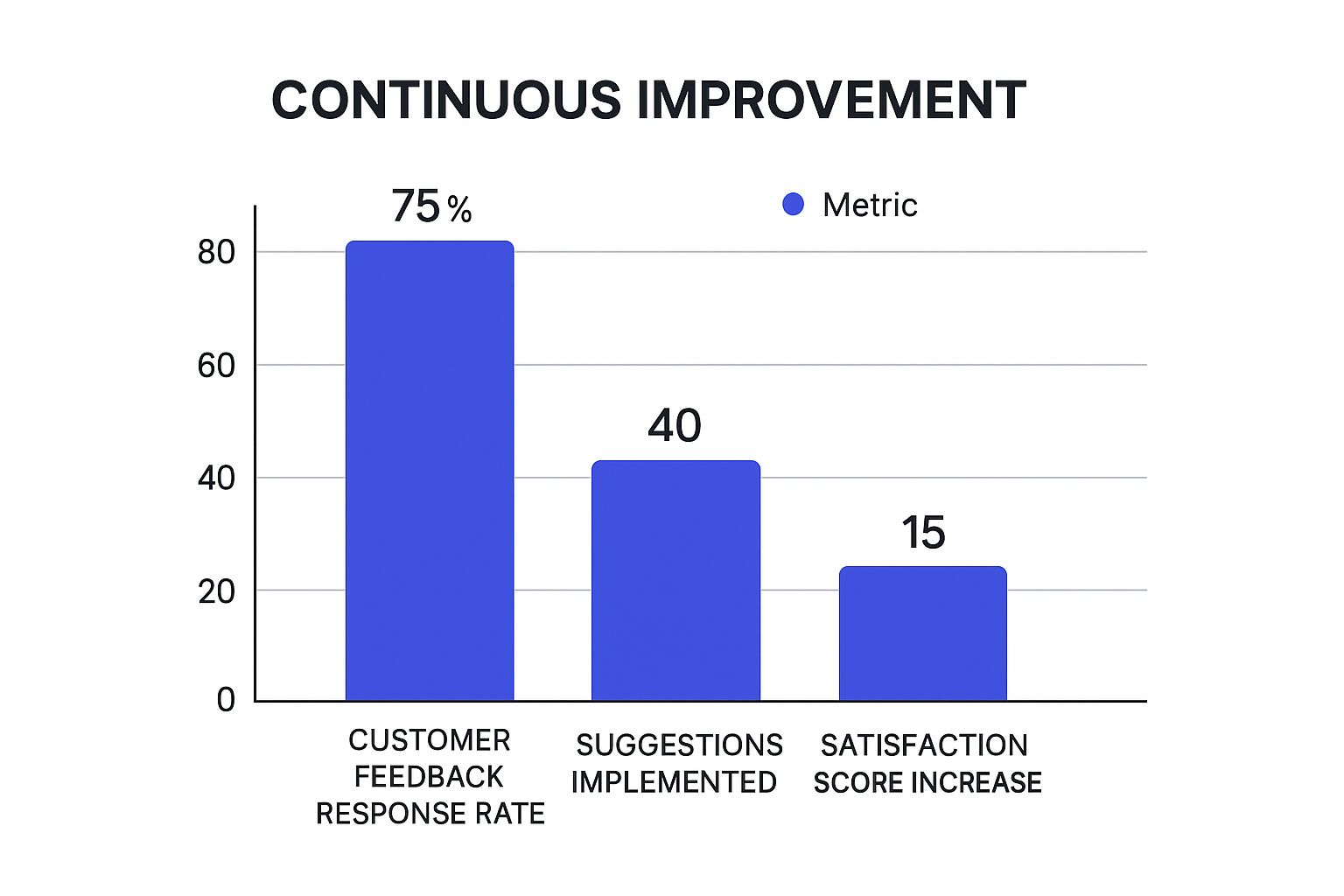How to Improve Customer Satisfaction: Top Proven Strategies
Learn how to improve customer satisfaction with effective strategies. Boost loyalty and grow your business today by implementing these proven tips.

To improve customer satisfaction, you have to get inside your customers' heads. What do they expect right now? Once you know that, the goal is to consistently deliver an experience that’s a little more personal, efficient, and empathetic than they were hoping for.
This means actively listening to what they’re telling you, using the right tech to solve problems fast, and building a team that genuinely puts the customer first in every decision.
Understanding the Modern Customer

Does keeping customers happy feel harder than ever? You’re not just imagining it. Many brands are struggling, and the data backs it up. We’re seeing a measurable dip in the quality of customer experiences across the board, making it a serious challenge for businesses of all sizes.
This isn't happening in a vacuum. With economic pressures mounting, customers demand more value from every single purchase. They’re much more selective with their money and have little patience for subpar service. Getting a handle on this new environment is the first step to building a strategy that actually works.
The Growing Experience Gap
There’s a massive gap between the experience companies think they’re delivering and what customers actually feel. This disconnect is the real reason satisfaction scores are tanking.
Forrester's Global Customer Experience Index from 2025 flagged a troubling trend: 25% of US brands saw their customer experience rankings fall for the second year in a row. At the same time, only 7% reported improvements. The data is clear: customers feel they’re getting less value and fewer positive interactions, especially as economic uncertainty looms. You can dig into the complete findings in the Forrester customer experience report.
This decline tells us that just meeting basic needs isn’t cutting it anymore. Customers expect more than a functional product or a polite service agent.
"Your customers don’t care how much you know until they know how much you care." – Damon Richards
This quote perfectly captures the shift. Customers are searching for a genuine connection and a sense that you truly value their business.
Key Factors Driving Customer Expectations
A few powerful forces are reshaping what customers expect from the businesses they support. These are not minor preferences; they're quickly becoming the new standard for what a "good" experience looks like.
Here are the key drivers you need to know:
- Immediacy and Convenience: In a world of on-demand everything, customers expect fast, frictionless access to information and help. Long waits or clunky processes are major deal-breakers.
- Hyper-Personalization: Generic, one-size-fits-all communication feels lazy and outdated. Customers expect you to know their history and preferences, offering relevant help without them having to ask.
- Seamless Digital Experiences: A buggy app, a confusing website, or a clunky checkout can instantly sour a customer's opinion of your brand. Every single digital touchpoint has to be smooth and intuitive.
- Authenticity and Transparency: People are far more likely to trust brands that are open, honest, and own up to their mistakes. Real authenticity builds a much stronger, more resilient customer relationship.
Once you recognize these new standards, you can start pinpointing where your own business can make meaningful improvements. The rest of this guide will walk you through actionable strategies to close that experience gap and truly learn how to improve customer satisfaction.
Why Good Service No Longer Guarantees Loyalty

For a long time, the goal was simple: make the customer happy. If they walked away from an interaction feeling good, you could chalk it up as a win. But today, providing "good service" is the bare minimum. It’s the price of entry.
Good service keeps you in the game, but it doesn't guarantee you'll win. The modern marketplace is just too crowded. A customer might be perfectly satisfied with a transaction, the product worked, the support agent was polite, but that single positive moment is rarely enough to build a real, lasting relationship.
The real challenge is bridging the huge gap between a satisfied customer and a truly loyal one.
The Satisfaction vs. Loyalty Gap
It's a story I’ve seen play out countless times. A business looks at its glowing CSAT scores and assumes everything is fine. But then, they're blindsided when those same "satisfied" customers jump ship to a competitor without a second thought.
This disconnect happens because satisfaction is often transactional, while loyalty is deeply relational. It's about emotion.
Recent data from the Qualtrics XM Institute’s 2025 Global Consumer Study puts this into sharp focus. While customer satisfaction is holding steady at a respectable 76%, key loyalty metrics like trust and repurchase intent are falling behind. It’s clear proof that just meeting expectations isn't enough to secure future business.
So, what turns a one-time happy customer into a long-term advocate? It usually comes down to three things:
- Trust: Does the customer believe you have their back, even when something goes wrong?
- Emotional Connection: Do they feel a genuine connection to your brand’s mission or values?
- Perceived Value: Do they feel you offer something more than just a good price?
A single positive interaction can create satisfaction. But it takes consistent, trustworthy, and emotionally resonant experiences to build genuine loyalty.
Beyond the Transactional Relationship
Loyalty isn't built on isolated moments of good service. It grows from a foundation of trust and a sense that your business actually understands a customer’s needs over time.
A satisfied customer thinks, "That was a good experience."
A loyal customer thinks, "This is a company I can count on."
A satisfied customer might not complain, but a loyal customer will actively promote you. They become your best marketers, sharing positive experiences with friends and even defending your brand when issues pop up.
Building this kind of relationship requires a shift in mindset. Instead of just focusing on resolving the immediate issue, you need to think about the entire customer journey. Every single touchpoint from marketing and sales to support and billing has to reinforce the same positive, trustworthy message. To really dig into this, you should explore proven strategies to build customer loyalty.
This deeper connection is also what helps you weather the occasional storm. A merely satisfied customer will likely leave after one bad experience. But a loyal one? They're far more likely to give you the benefit of the doubt and a chance to make things right.
That resilience is a direct result of the trust you’ve built, and it’s a critical factor in long-term success. Failing to build this bond is one of the fastest ways to see churn rates climb. To learn more, check out our guide on how to https://www.chatiant.com/blog/reduce-customer-churn.
Using Personalization to Meet Customer Expectations
Today’s customers don’t just appreciate a personal touch; they flat-out expect it. A generic, one-size-fits-all approach feels lazy and disconnected. To really move the needle on customer satisfaction, you have to show customers you get who they are and what they need, often before they even ask.
This goes way beyond plugging a {{first_name}} into an email. It’s about creating a cohesive, relevant experience at every single touchpoint, from the ads they see to the support conversations they have. The data is clear: this isn’t a nice-to-have anymore. It's a core requirement.
The New Standard of Customer Interaction
Personalization has become a huge factor in whether a business sinks or swims. According to Zendesk’s Customer Experience Trends Report, a whopping 76% of customers will expect personalized experiences from brands by 2025.
When brands get this right, they are 71% more likely to see improved customer loyalty. This is especially true for younger customers like Gen Z, who already make up about 40% of the global consumer base.
This shift means personalization is fundamental to building a lasting relationship with your audience. It's a direct path to higher satisfaction scores.
“Getting personalization right means creating a more human connection. It’s about making each customer feel seen, heard, and valued as an individual, not just as another number in your database.”
By using data ethically and thoughtfully, you can craft experiences that actually resonate. This builds trust and shows customers you're invested in their success, not just their wallet.
How to Implement Effective Personalization
Getting started with personalization doesn't have to be a massive, complicated project. It really just begins with gathering the right information and using it to make every interaction more relevant. This means using customer behavior, purchase history, and stated preferences to shape both communication and support.
For instance, a customer who constantly buys hiking gear shouldn't be seeing ads for beach towels. Simple, right? Similarly, a support agent should have a customer's entire ticket history on screen so they don't have to ask, "Can you explain the problem... again?"
Here are a few practical ways to get going:
- Segment Your Audience: Group customers based on shared traits like purchase history, location, or how often they engage. This lets you send marketing campaigns that actually feel relevant.
- Leverage Past Interactions: Use data from old support tickets or past purchases to inform new conversations. An agent who already knows a customer's history can provide smarter, faster help.
- Customize Your Website Experience: Show different content or product recommendations based on a visitor's browsing behavior. It makes your site feel less like a static brochure and more like a helpful guide.
These actions prove you’re paying attention, which is one of the most powerful ways to boost customer satisfaction.
The infographic below highlights some key metrics that track the impact of these kinds of customer-focused initiatives.

As you can see, there’s a clear line connecting action on feedback with a real-world jump in satisfaction scores.
Choosing the Right Personalization Tactics
Not all personalization efforts are created equal. Some deliver massive wins, while others require a ton of resources for a small payoff. The key is figuring out where to invest your time and energy. For a small business, jumping straight to a fully dynamic website might be overkill, but nailing personalized email campaigns is totally achievable.
The goal is to pick strategies that align with your team's capabilities and will have the biggest impact on your specific audience.
To help you map this out, I've put together a quick comparison of some common personalization tactics.
Effective Personalization Tactics Compared
This table breaks down different tactics by their impact, the effort required to implement them, and the scenarios where they shine the brightest.
By looking at this table, you can make a much more informed decision about where to start. Even small steps, like giving your support team better context on past interactions, can lead to huge gains in how customers feel about your brand.
Building a Truly Customer-Focused Team

True customer satisfaction isn’t the job of a single department; it reflects your entire company’s culture. If your marketing, sales, and support teams are operating in separate worlds, your customers are the ones who feel the disconnect.
Building a truly customer-focused team means intentionally tearing down those internal walls. The goal is a single, unified experience where every interaction feels like a continuation of the last. This takes more than just new software; it's a fundamental shift in how your teams talk to each other, share information, and define success.
Redesigning Workflows Around the Customer
Many companies build their teams around internal functions like "sales" or "support." A customer-centric approach flips that model on its head. Instead, you design your workflows around the customer's journey, from their first click to their most recent support ticket.
This means sales needs to see support issues to see a customer's frustrations. Marketing should know what problems customers are running into to create more relevant content. And support agents need context from the sales process to offer help that’s actually personalized.
I saw this in action at a software company that noticed a flood of support tickets from new users confused about a specific feature. Instead of just letting the support team handle it, they pulled in the marketing and product teams. Marketing created a new onboarding email explaining the feature, and the product team simplified its UI in the next update.
By getting different departments to work together, they didn't just solve a support problem, they stopped it from happening in the first place. That proactive approach is the hallmark of a truly customer-focused company.
This shift turns your support team from a reactive cost center into a valuable source of business intelligence.
Training for Empathy and Active Listening
Knowing your product inside and out is only half the battle. Often, the soft skills your team possesses make or break a customer's experience. Training has to go beyond product features and focus on critical communication abilities.
Great customer interactions really boil down to a few key skills:
- Active Listening: This is about truly hearing what the customer is saying (and not saying) without just planning your response. It’s giving them your full attention to get to the root of their problem.
- Empathy: It’s the ability to connect with a customer’s feelings. A simple "I can see why that would be frustrating" can completely change the tone of a conversation.
- Clear Communication: This means explaining complex things simply and making sure the customer understands the next steps. Ditch the jargon and stick to positive, solution-focused language.
Investing in this type of training is a direct investment in customer satisfaction. When your team can navigate tough conversations with grace, they turn potentially negative experiences into positive ones.
Creating a Unified Information Hub
One of the biggest roadblocks to a seamless customer journey is scattered information. A customer should never have to repeat their story every time they're handed off to a new agent or department. The fix is a single source of truth for every customer interaction.
This could be a CRM, a shared database, or a dedicated customer service platform. The specific tool matters less than the principle: every team member who talks to a customer should see their complete history.
This includes:
- Past purchases and orders
- Previous support tickets and their outcomes
- Notes from sales calls or meetings
- Which marketing campaigns they’ve engaged with
When an agent can pull up this full picture, they can provide context-aware support that makes the customer feel seen and valued. This level of preparedness is key for improving both satisfaction and your own team's operations. If you want to dig deeper, check out our guide on boosting customer service efficiency.
By uniting your teams with shared goals, shared information, and shared skills, you create a powerful engine for customer happiness. This internal alignment is the foundation every great customer experience is built on.
Measuring What Actually Matters to Your Customers
If you want to improve customer satisfaction, you have to stop guessing and start measuring. Without solid data, you're just making changes in the dark and hoping something sticks. A good metrics dashboard gives you a clear, objective view of how customers really feel, showing you exactly where to focus your efforts.
While it's tempting to lean on one or two popular scores, the best approach combines several key performance indicators. This mix gives you a much fuller picture, helping you see beyond a single interaction to the entire customer relationship.
Moving Beyond Simple Scores
The most common metrics are a great starting point, but they don't tell the whole story on their own. Each one reveals a different piece of the puzzle. Let's break down the important ones you should be tracking.
Customer Satisfaction Score (CSAT): This is the classic "How satisfied were you?" survey, usually sent right after a specific interaction like a support chat or a purchase. It’s perfect for getting immediate feedback on a single touchpoint. A CSAT score gives you a real-time pulse on how well you're handling those individual moments.
Net Promoter Score (NPS): This metric looks at long-term loyalty by asking how likely a customer is to recommend your brand. It separates your customers into Promoters, Passives, and Detractors, giving you a high-level view of your brand's health. Think of NPS as a strong indicator of future growth.
These two are foundational, but relying on them exclusively creates blind spots. Sure, you might have a high CSAT score from a friendly support call, but if the customer had to jump through hoops just to get there, are they truly happy?
You can't just measure happiness; you have to measure effort. The less work a customer has to do to solve their problem, the more loyal they will become. This is where the next metric becomes so important.
Uncovering the Full Picture with Deeper Metrics
To get a more accurate read on the customer experience, you need to add metrics that measure the effort involved and the ultimate outcomes of your service.
Customer Effort Score (CES) is a total game-changer. It asks customers a simple question: "How easy was it to get your issue resolved?" A Gartner study found that 96% of customers who had high-effort experiences reported being disloyal, compared to just 9% for low-effort experiences. Reducing friction is one of the most direct paths to improving satisfaction.
Finally, you absolutely must track your Customer Retention Rate. This shows the percentage of customers who stick with your business over a specific period. It’s the ultimate proof that what you're doing is actually working. A rising retention rate is a clear sign that you’re building lasting relationships, not just processing transactions.
When you track these four metrics together, you get a much more balanced and honest view. For a more detailed guide on turning this data into action, check out our post on analyzing customer feedback.
Key Customer Satisfaction Metrics
Here's a quick summary of these important metrics, what they measure, and when they are most effective. Using them in combination helps you build a comprehensive strategy for improvement.
Building a dashboard with this data moves you from reacting to problems to proactively shaping a better customer journey. These numbers aren't just scores; they're stories telling you exactly where you're winning and where you need to improve.
Got Questions About Improving Customer Satisfaction? We’ve Got Answers.
As you start putting these strategies into action, a few common questions always seem to pop up. Getting straight answers can help you cut through the noise and focus on what will actually move the needle.
Let's tackle some of the most frequent hurdles businesses face.
What’s the Most Effective First Step?
Before you spend a dime on new tools or overhaul your workflows, the best place to start is simply by listening. You need a clear, unfiltered picture of what your customers are actually experiencing.
This means going beyond scheduled surveys. Look into your online reviews, both the good and the bad. Talk to your frontline support team, the ones who hear it all day. Check your social media mentions. This raw feedback is a goldmine, pointing you directly to the biggest friction points in your customer journey.
The most powerful insights often come from unsolicited feedback. These are the issues customers feel strongly enough about to share without being prompted, highlighting the problems that cause the most frustration.
Fixing the things your customers are already complaining about will always deliver the fastest, most noticeable improvements.
How Can a Small Business Succeed on a Tight Budget?
Small businesses have a secret weapon: personal connection. It’s an area where you can consistently outperform larger, more impersonal competitors. You might not have a huge support team or an expensive CRM, but you can build genuine, memorable relationships.
Simple things make a huge difference. Use customer names in your emails. Remember small details from past conversations. Send a personal follow-up after a purchase just to see how things are going. That personal touch shows you actually care.
Another key is giving your team the power to solve problems on the spot. When an employee can fix an issue without needing three levels of approval, it feels incredible to the customer. A quick, empathetic response from a small business is often far more valuable than a slow, scripted one from a big corporation. Responsiveness costs nothing but builds immense goodwill.
How Long Does It Take to See Results?
This really depends on the scale of your changes. For small, tactical adjustments, you can see a positive shift in just a few weeks. Tweaking your support team's first response time or adding a solid FAQ page can immediately cut down on customer frustration.
Bigger, more strategic shifts take more time to bear fruit. If you're overhauling your entire onboarding process or trying to build a more customer-centric culture, you're looking at a three to six month timeline before you see a measurable lift in metrics like NPS or customer retention.
The key here is consistency. One-off efforts fade quickly. Sustained, focused effort is what creates real, lasting improvements.
Is Investing in Technology Always the Best Solution?
Technology should be a tool to solve a specific problem, not a solution looking for one. Throwing money at tools like AI chatbots isn't always the right move, and a clumsy implementation can create more problems than it solves.
For instance, AI chatbots are fantastic for handling common questions 24/7. This can definitely boost satisfaction for customers who need a quick answer outside of business hours. But they become a major source of frustration if they're poorly programmed, can't understand complex issues, or block customers from reaching a human when they really need one.
The best approach is often a hybrid model. Use automation for the simple, repetitive stuff. This frees up your human agents to handle the complicated, emotional, or high-stakes conversations where their empathy and critical thinking really shine. Technology should assist your team, not replace them.
Ready to provide instant, personalized support that boosts satisfaction? Chatiant lets you build custom AI chatbots trained on your own data. Our platform makes it easy to create AI agents that can handle common questions, look up customer data, and seamlessly hand off complex issues to your team. Learn how Chatiant can transform your customer experience.


